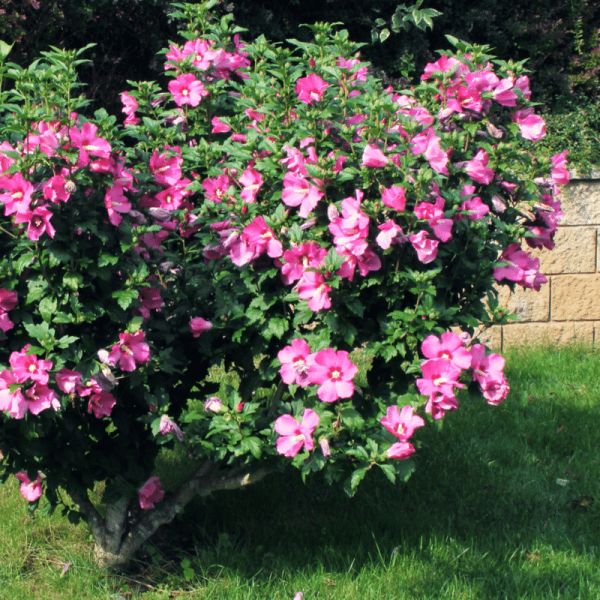Caribbean vacationers returning to harsher climates fondly recall those spectacular Hibiscus flowers that are ubiquitous and bloom so profusely in the tropics. Of course those tender tropical beauties won’t survive our New England winters outdoors. But don’t despair—there are two types of Hibiscus well suited to enjoy in your yard here at home as pleasing reminders until your next trip south. The numerous cultivars of Rose-of-Sharon (sometimes called “Althea”, botanically Hibiscus syriacus), along with “hardy Hibiscus” (Hibiscus moscheutos cultivars) add colorful extended flowering times, adaptability and summer garden interest for most every Northeast garden.
Growing to 12 ft. high, Rose of Sharon produces continuous bloom from early July, often until frost, a far longer flowering period than most other woody shrubs. Flowers are 3-5” diameter, opening every day for many weeks along the stems. Cultivar colors range from pure white to pink, red and blue, single to double. Some newer cultivars are more compact growing, well suited for smaller gardens.
Hardy Hibiscus is an herbaceous shrub that rapidly reaches 4-6 ft. high by the end of summer. Starting around July, each branch produces a profusion of huge pink, white or red flowers, depending upon the cultivar; in a sunny location with sufficient fertility and moisture, individual blooms can be 12” diameter–even more spectacular than those tropical Hibiscus!
Because it’s a dense and vigorous woody shrub, Rose of Sharon is a fine choice for hedging and creating private outdoor rooms around your home. It tolerates shearing and sets flowers on new growth, so pruning at any season is acceptable. And even though it drops all foliage in winter and is less view-blocking than an evergreen screen, its thickly-held branching functions effectively as a windbreak. Nearly pest-free, it performs best in full sun, but will adapt to most any soil or light condition around the yard except full shade. It can be trained to grow in a tree-form by periodically removing lower branches.
Both types of Hibiscus are later than most plants to begin growing in spring. Hibiscus syriacus foliage usually waits until May to appear, so be patient. Hibiscus moscheutos is herbaceous, dying back to the ground each winter, its new stems sometimes not emerging until June.
Be on the lookout for unwanted seedlings some cultivars produce. These volunteer seedlings are easy to recognize when they germinate, and they are readily removed by pulling them up when young. Left to grow, they can develop into new plants with flower colors that differ from their parent. Most homeowners agree that this bit of maintenance is well worth the value these Hibiscus plants add to your summer garden.







